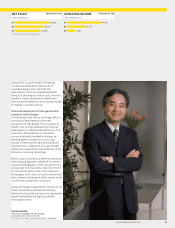Nikon 2007 Annual Report Download - page 21
Download and view the complete annual report
Please find page 21 of the 2007 Nikon annual report below. You can navigate through the pages in the report by either clicking on the pages listed below, or by using the keyword search tool below to find specific information within the annual report.
NIKON ANNUAL REPORT 2007 19
07
06
05
57,244
49,832
44,253
07
06
05
2,102
1,929
(647)
OPERATING INCOME (LOSS) MILLIONS OF YEN
NET SALES* MILLIONS OF YEN
Years ended March 31
*The above figures include intersegment sales.
Years ended March 31
In the year under review, Nikon established
a new Shonan branch on the site of the
Sagamihara Plant to house the necessary
facilities for manufacturing and supplying
LCD photomask substrates. These included
a clean room, a large polishing machine
and inspection equipment. Currently Nikon
can supply photomask substrates for 5th to
8th generation LCD panel manufacturing
processes.
Mask size continues to increase as LCD
panels become larger. Nikon decided to
enter this business because the ability to
integrate the synthesis of large, high-quality
silica glass with high-precision polishing,
linked to the expertise that Nikon possesses
in LCD scanners, enables Nikon to supply
LCD panel-makers with process-optimized
substrates. This business is expected to
make a steady contribution to Nikon Group
profits, since it is fairly insensitive to the
silicon investment cycle and should
generate stable demand for consumables.
Nikon Rayfact 2.0x high-performance
lens launched for line-scanning sensors
The degree of precision required in the
external inspection of printed circuit boards
and other electronic components is rising
amid ongoing miniaturization of devices.
Inspection based on image-processing
technology has become the norm in the
industry. The sensors used to analyze the
lines in the circuitry must operate at ever
increasing degrees of resolution, which in
turn raises the performance requirements
for the scanning lens. At the same time,
concerns about environmental issues are
boosting demand for eco-friendly glass that
is free of substances such as lead or arsenic.
The Nikon Rayfact 2.0x lens (95mm F2.8) is
made from eco-friendly glass and provides
high resolution from the center to the
periphery of the image. This uniformity of
performance reduces image distortion,
ensuring an even image across the entire
device surface, even with large line-
scanning sensors.
Nikon Fieldmicroscope EZ-Micro
awarded prize for good design
The Fieldmicroscope EZ-Micro, which was
developed by Nikon as a portable
stereoscopic microscope for outdoor use,
was one of the products to receive a Good
Design Gold Prize at the Good Design
Awards 2006 organized by the Japan
Industrial Design Promotion Organization.
Demand has increased for products that
allow users to observe and capture images of
microscopic objects with ease outdoors. This
series of products is the first to enable this by
creating a field microscope with a modified
light path and special bracket to hold a
digital camera. The EZ-Micro is designed to
work with the COOLPIX series (a camera is
included in some models), thus making it
simple to capture the image. Due to the ease
of observation and image recording, this
product has a broad range of applications,
including such industrial and commercial
uses as electronic component inspection or
the appraisal of precious stones.
NIKON FIELDMICROSCOPE EZ-MICRO
NIKON RAYFACT 2.0X
HIGH-PERFORMANCE LENS
























